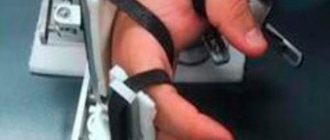Causes of body numbness
If body numbness is not due to circulatory problems, freezing or nerve compression, this may indicate the development of the following diseases:
- Radicular syndromes (radiculitis, radiculopathy associated with inflammation, vascular disorders or mechanical compression of nerve roots in segments of the spine and spinal cord, intervertebral hernia) are the most common cause of paresthesia, and usually several fingers or part of the arm go numb, rather than the entire limb. In some cases, numbness of the body is accompanied by a burning sensation, the intensity of which increases at night;
- Polyneuropathy - manifests itself in patients with diabetes, when, as a result of metabolic disorders due to prolonged elevated levels of glucose in the blood, damage to peripheral vessels and nerves occurs. In this case, patients complain of a symmetrical disturbance of sensitivity, most often in the periphery of the arms and legs;
- Stroke is the most dangerous cause of body numbness, when, due to an acute cerebrovascular accident, areas of the brain responsible for the sensitivity of certain parts of the body are damaged. With a stroke, the nature of the disorder is always one-sided, that is, only numbness occurs on the right side of the body (or only on the left), and the damage can spread to the limbs or to the entire half of the body, including the face. Other symptoms of a stroke include impaired motor function, changes in vision, difficulty speaking;
- Brain tumor - due to the fact that the tumor compresses the surrounding areas of brain tissue and causes disruption of their functioning, headaches, difficulty moving the limbs, blurred vision, weakness, weight loss, decreased appetite and periodic paresthesia may occur. The nature of the sensitivity disorders is usually one-sided; numbness is observed on the left side of the body, face or only the limbs (or, conversely, on the right side). Unpleasant sensations do not arise acutely, but increase over time;
- Multiple sclerosis is a chronic disease of the central nervous system, which is characterized by the replacement of areas of the nervous tissue of the brain with connective tissue, which causes numbness of body parts with loss of sensitivity and control over movements, blurred vision, etc.
The causes of body numbness can also be Raynaud's syndrome, cerebral circulatory disorders, vascular atherosclerosis, as well as recent surgeries in different parts of the body.
Stroke
When a stroke occurs in the brain tissue, a blood vessel is blocked by a thrombus (ischemic) or the vessel ruptures and hemorrhages into the brain (hemorrhagic stroke). In both cases, an acute disruption of the blood supply to the brain area and its death develops.
This is the most dangerous of the pathologies, which can manifest itself in the form of numbness of half the face, while paralysis of the facial muscles develops on one side, they sag - the person develops a characteristic crooked smile.
- Ask the patient to say his name - during a stroke, due to paralyzed muscles, he will not be able to speak clearly and clearly, his speech will be similar to the speech of a drunk. The person also has trouble swallowing.
- Ask to raise both arms - usually with a stroke, due to muscle weakness, he will not be able to lift at least one arm.
- Ask to stick out your tongue - its tip will point to the side.
Other symptoms include weakness, dizziness, confusion, and temporary loss of vision in one or both eyes.
During a stroke, minutes count. The sooner you can get to the doctor, the greater the chance of recovery from illness.
This condition is considered one of the most dangerous causes of sensory impairment. Numbness in this case develops as a result of an acute circulatory disorder caused by blockage of blood vessels supplying the brain or hemorrhage. As a result, areas responsible for the sensitivity of one or another area of the body are damaged. In this case, paresthesia occurs on one side of the body according to the hemitype: or the entire half of the body, including numbness of the skin of the face or limbs.
Causes not related to diseases
For many people, facial numbness is not associated with any pathology. It can be called:
Strong excitement. Often people's faces and lips go numb during a quarrel. The reason for this reaction is hypertonicity of the facial muscles, which can occur, for example, with excessive compression of the jaw muscles. The same phenomenon will be observed in people during strong, prolonged laughter.
- Fear. As a rule, when a person is frightened, his jaw goes numb. This is due to two factors: frequent but shallow breathing, as well as muscle tension.
- Squeezing blood vessels. This happens, for example, if you prop your chin or cheek with your hand for a long time. Unpleasant sensations in this case will be localized on the left or only on the right side of the face.
- Inconvenience during sleep. If you are wondering why your face goes numb immediately after sleep, you need to look for the answer in the peculiarities of your rest. So, due to an uncomfortable pillow or incorrect sleeping position, blood circulation in your muscles may be impaired. Just change your pillow or try a new sleeping position and it will all go away in a matter of days.
- No breaks during work. What does it mean? If you sit in one place for a long time, for example, working at a computer, you will also feel your cheek or chin go numb due to poor blood circulation. To cope with this symptom, you need to do a short warm-up every 45 minutes while working.
- Taking certain medications. With this side effect, as a rule, the cheekbones of the face go numb; less often, the symptom spreads to other parts of the face.
If your attacks recur regardless of your emotional state and work rhythm, you should look for the answer to what makes your face go numb in the descriptions of various diseases. Let's take a look at them in more detail.
Prevention
For prevention, you will have to avoid hypothermia, use a thermos, and fill it with tea. The drink helps restore blood circulation and neutralize negative symptoms. Antihistamines are often used. You need to understand that therapy is prescribed after examination by a doctor. Many individual patient characteristics must be taken into account.
You will have to protect the body from harmful external factors. It is advisable to avoid drafts, not to contribute to the development of chronic pathology, you will need to saturate the body with necessary microelements.
Pathological numbness on the left side of the body
Numbness on the left side of the body is a symptom of three diseases. Most often, ailments are usually associated with a stroke. This disease occurs due to impaired blood circulation in the brain. The vessels that provide nutrients to the important organs of our body become clogged. In some cases, a stroke causes bleeding directly into the brain or under its membranes. The main feature of paresthesias during stroke is their one-sided nature. This means that numbness on the right side of the body is also a symptom of this disease. The entire half of the body, including the face, or only the limbs is subject to paresthesia. In addition to numbness, the disease is accompanied by speech impairment, changes in vision, and loss of coordination.
The unilateral nature of paresthesia is also a sign of a brain tumor and similar ailments (vascular aneurysms, dural hematomas). The main symptom of such ailments is their frequency: from time to time the pain arises and then subsides, accumulating intensity with each cycle.
Loss of sensitivity in the limbs is also observed when the central nervous system is disrupted - in patients with multiple sclerosis. Part of the membrane of the nerve endings of the brain is destroyed and begins to be replaced by connective tissue. As a result, the body becomes numb, the mobility of the limbs is lost, and vision deteriorates.
Less severe cases of paresthesia occur in people suffering from polyneuropathy and radicular syndrome. The first group of people most often includes diabetics. When glucose levels increase, they experience damage to peripheral nerves and blood vessels. This is characterized by numbness in the periphery of the extremities (hands, fingers, feet). The second group includes patients with radiculitis. The disease causes pinching of nerves in segments of the spine and spinal cord. Parts of the limbs go numb: several fingers, a hand. With radicular syndrome, patients experience a burning sensation in a numb part of the body, which intensifies at night.
Numbness can also occur due to Raynaud's syndrome, after recent operations and with vascular atherosclerosis.
Question answer
Question: What reasons can cause numbness in the face if the doctor has not identified any abnormalities in my health?
Answer: Facial paresthesia can be caused by: an uncomfortable pillow, irritable and impulsive behavior, prolonged immobility in one position, as well as attacks of panic or fear.
Question: What techniques help overcome facial numbness?
Answer: You can use physiotherapeutic methods: acupressure, acupuncture, ultraphonophoresis.
https://youtube.com/watch?v=cvrgx6ylg7s
Numbness of the face occurs quite often and in many people. Moreover, this unpleasant symptom can be a sign of a huge number of diseases. Including one of the precursors of stroke and micro-stroke, a manifestation of multiple sclerosis, a complication of inflammation of the trigeminal nerve and many other diseases. Therefore, if you feel numbness in your face, it is better to immediately contact your local physician, who will most likely refer you to a neurologist for consultation.
According to statistics, in no more than every fifth patient with complaints of facial numbness, this symptom indicates some dangerous disease. Most often, the occurrence of this symptom is caused by less global causes. It can also be caused by simple hypothermia or severe nervous stress. Also, numbness of the face can be a sign of osteochondrosis. Facial numbness, accompanied by loss of taste on one side of the tongue and pieces of food getting stuck between the front teeth due to the inability to “push” food into the esophagus, may be a sign of damage to the facial nerve. The same one that is responsible for the action of all facial movements of a person. In this case, numbness can take a chronic form, affecting, among other things, facial expressions, which will change facial features.
In any case, this symptom means that the blood supply has deteriorated in the part of the body that is numb. After all, numbness in most cases is due precisely to the fact that certain muscles “pinch” the nerve, preventing impulses from passing through it from one or another part of the body.
Doctors often advise those who often suffer from numbness in certain parts of the body, including numbness in the face, to check the sensitivity of the numb area. To do this, just try to prick the numb area with a needle. Most often, this simple experiment will demonstrate that nothing bad is happening in the body. In this case, numbness can be easily combated by simply massaging or rubbing the numb area. This test is intended for those who like to “listen” to their body and find manifestations of various diseases. Sensitivity to pain will ideally remove suspicion of paralysis of an area of the body, which is inevitable during a stroke.
“One-time” numbness of the face should not force you to immediately try to find any complex disease. It may be a manifestation of the consequences of a blow to the face. Like arms and legs, the face can become numb after a person has been in an uncomfortable position for a long time, pinching blood vessels and disrupting blood flow. If such numbness does not go away and is not relieved by self-massage, your local therapist will always suggest options for getting rid of numbness.
Facial numbness, which is repeated frequently, or in situations where facial numbness does not go away, becoming a constant manifestation of any disturbances in the body, should alert you and make you think about the need to consult a specialist. For any frequently recurring numbness, you should consult a doctor.
Physiotherapy
Physiotherapeutic procedures can be used separately or in combination with the main methods of treatment. Let's list the main ones:
- Acupuncture is an effect on certain points responsible for the functioning of individual organs or the performance of specific functions.
- Acupressure is a type of acupressure that is successfully practiced in modern medicine around the world.
- Ultraphonophoresis, in which ultrasound radiation is used to introduce medications under the skin.
- This physiotherapy helps improve blood circulation, lymphatic drainage, and eliminate the feeling of numbness.
There is no concern when paresthesia appears once and continues for a long time. If seizures recur regularly, it is advisable to get examined by a doctor as soon as possible. You need to be treated on time, so you can get rid of complications and dangerous pathologies.
Some believe that facial numbness occurs due to phlebological disorders. Others argue that only advanced forms of the disease exhibit such symptoms.
Symptoms
Symptoms will depend on the underlying cause. Common clinical manifestations include:
- unpleasant tingling sensation;
- “crawling” sensation;
- loss of sensation in the affected area.
Depending on what caused the manifestation of this symptom, the general clinical picture will be accompanied by specific symptoms.
Numbness of the face with cervical osteochondrosis will be accompanied by the following clinical picture:
- crunching in the neck when turning the head;
- aching pain in the neck, head, and can radiate to the shoulder blades;
- dizziness;
- noise in ears;
- blurred vision;
- decreased performance, irritability;
- Numbness is usually observed on the right side.
In more complex cases, osteochondrosis may present with impaired motor activity.
In some cases, this symptom may be present with VSD, however, it should be noted that this sign is not mandatory for this clinical picture. If this occurs, then numbness of the face will be accompanied by the following clinical picture:
- deterioration of sensitivity of the limbs;
- weakness, decreased performance;
- disorders of the functioning of the gastrointestinal tract;
- dyspnea;
- frequent fainting, which is almost always accompanied by dizziness;
- disruption of the usual sleep cycle;
- heart rhythm disturbance;
- convulsions, especially at night.
Numbness of the face and other parts of the body is one of the first signs of multiple sclerosis, which will be characterized by the following clinical manifestations:
- speech impairment – the patient cannot clearly pronounce some sounds or whole words;
- increasing weakness;
- impaired motor function, loss of coordination;
- it becomes difficult for the patient to swallow food;
- trembling in the lower and upper limbs.
This symptom is almost always present during a stroke. In this case, only unilateral numbness of the face is observed, which will be accompanied by the following clinical picture:
- slurred speech – the patient cannot pronounce simple words;
- loss of coordination of movements or partial paralysis;
- high blood pressure;
- increased heart rate;
- loss of consciousness.
It should be noted that the initial clinical picture of stroke and multiple sclerosis is somewhat similar, therefore, if such symptoms are present, emergency medical care should be called, since stroke has a high risk of death.
Associated symptoms
It is important to remember that frequent and prolonged attacks of numbness of the face, half or some part (lips, nose, forehead, cheeks, chin) are a sign of the disease and determining the cause of this pathological process, promptly seeking advice from a specialist, examination and adequate treatment - the key to a speedy recovery.
The most complex, dangerous and unfavorable prognosis (in case of untimely diagnosis and treatment) diseases in which a symptom of numbness of the face or part of it may occur are considered:
- trigeminal neuritis, migraine;
- neurosis, depression or vegetative-vascular dystonia;
- cold allergy;
- osteochondrosis and cerebrovascular accidents;
- multiple sclerosis, syringomyelia;
- shingles;
- avitaminosis;
- lesions of the facial nerve.
Signs of numbness are caused by pathological factors. The main clinical manifestations include:
- Tingling.
- Goosebumps.
- Deterioration of sensitivity.
Depending on the specific causes of symptoms, the general clinical picture will be accompanied by the following symptoms:
- The neck crunches when turning the head.
- Aching pain moving to the shoulder blades.
- My head is spinning.
- There is a noise in my ears.
- Vision problems.
- Poor performance.
- The right side is numb.
In a complex condition, motor activity may deteriorate. In some situations, such a sign is detected during VSD; it should be noted that such a symptom is not considered mandatory for a long-term clinical picture:
- Poor sensitivity in hands and feet.
- Performance deteriorates and a feeling of weakness appears.
- Disorders in the gastrointestinal tract.
- Dyspnea.
- Fainting state.
- Sleep problems.
- Deterioration of heart rhythm.
- Convulsive state.
Numbness in the face and other areas may indicate multiple sclerosis. This pathology is characterized by the following accompanying symptoms:
- Problems with speech function.
- Weakness increases.
- Problems with movement, poor coordination.
- The swallowing reflex becomes difficult.
- Hands and legs are shaking.
Such signs are always present during a stroke. The face may only go numb on one side.
Symptoms:
- Speech is unclear and the patient has difficulty speaking.
- Problems with coordination of movements.
- Increased blood pressure.
- The heart rate is too fast.
- Consciousness is lost.
It should be borne in mind that the primary symptoms of a stroke are similar. Therefore, if you have such signs, you need to call a doctor. A stroke increases the risk of death.
Treatment
Why does my face go numb? The reason may be normal body fatigue, irregular work schedule, lack of sleep or insomnia. In this case, proper rest will help. Experts recommend listening to your body and its needs more often in order to avoid overexertion and serious illnesses in the future.
Facial numbness caused by an uncomfortable posture does not require medical intervention. It is enough to take a comfortable position and relax. To speed up the process, you need to rub the skin in the tingling area.
Sometimes numbness of the face on the left or right occurs after visiting the dentist, however, as a rule, it quickly disappears on its own. If this does not happen, you should consult your doctor.
When the cause of this problem is a lack of vitamins, a specialist prescribes the necessary medications. Multiple sclerosis requires corticosteroids and vitamin B.
For a disease of the facial nerve, a personally developed course of treatment is required. Painkillers and anti-inflammatory drugs are often used. In addition to medications, exercises for the right or left side of the face can have a good stimulating effect.
Sometimes numbness goes away after wiping part of the face with alcohol tincture. Yoga and meditation classes, as well as a massage course, speed up recovery.
In some cases, the cause of the disease is an allergy to cold. This is accompanied by itching and rash on the skin, and sometimes swelling.
Allergies can result from infectious or chronic diseases. To cure, you first need to visit an allergist.
As a preventive measure, it is advised to try to avoid hypothermia and take a thermos filled with hot tea with you. The drink will help restore blood circulation and neutralize symptoms. Antihistamines are often prescribed.
You should know that any treatment should be prescribed only after a complete examination of the patient. In this case, it is necessary to take into account many human characteristics.
If this pathology is accompanied by additional problems, for example the development of pimples on the head, concomitant treatment is prescribed.
Treatment methods
Treatment will depend on what exactly caused the illness. If a person is getting ready for bed and finds that his face is numb, it is important to restore blood circulation with a little massage. However, if in addition to this, paralysis of other limbs is observed, you should immediately contact a specialist.
Immediate hospitalization is required for numbness due to back, head or cervical injuries. Uncontrolled bowel movements should also be considered alarming symptoms.
Weakness and prolonged dizziness often accompany facial numbness; this is also an alarming symptom. However, it cannot be said for sure that it is the numbness of the right side of the face or the left that is a symptom of any disease.
If there is a lack of vitamins, the attending physician can prescribe microelements or, in extreme cases, recommend dietary supplements. Despite the fact that the treating doctor will not give direct recommendations of this nature, yoga or meditation can be an effective remedy.
For trigeminal neuralgia, drugs that reduce inflammation are used. In some cases, painkillers are prescribed. The trigeminal nerve exits in front of the auricle and divides into 3 branches. Usually only the lower part becomes inflamed, while the upper part remains unaffected.
Physiotherapeutic methods include the following:
- Acupressure. The method consists of a targeted effect on the affected areas of the face. It is done with the help of fingers, at this time the points are activated, which allows you to relieve numbness. The area of acupressure treatment depends on which part of the face is affected. If the left side of the face is numb, massage is performed only on the left side; if the right side is numb, massage should be performed on the right side.
- Acupuncture. Acupuncture can be called more clearly - acupuncture. It is used to administer certain medications.
- Ultraphonophoresis. Allows you to use ultrasonic waves to get rid of facial numbness by injecting medication into the subcutaneous cells.
These methods allow you to completely get rid of facial numbness if it is not caused by serious diseases. The procedures restore blood circulation and lymphatic drainage in the skin.
If during the examination it was revealed that the patient’s right side of the face is numb, then it is quite possible that the methods listed above will be able to completely eliminate this ailment. However, numbness will not go away if its cause is hidden in a more serious illness.
When the above does not provide any relief, a more serious condition is very likely. At the same time, timely diagnosis is important, because the disease can be started. It is worth noting that to prevent facial numbness, it is recommended to lead a healthy lifestyle. This includes proper nutrition, exercise, and good, sound sleep. For example, if the left side of your face is numb, but the right is not, this may be a consequence of both an unhealthy lifestyle and developing pathologies.
Constant movement reduces the likelihood of facial numbness, paying enough attention to monitoring the musculoskeletal system and tissue blood supply will minimize the risk of numbness. Food must necessarily contain B vitamins and the necessary set of minerals.
In other words, it is important to monitor your lifestyle and, if necessary, immediately seek the help of specialists. In this case, prevention is much easier than dealing with emerging diseases. Facial numbness should be taken extremely seriously as it can lead to various adverse effects. If the right side of your face is constantly numb, you need to change your lifestyle and consult a specialist for advice.
Provoking factors may include simple fatigue and poor sleep. You need to rest regularly. Doctors advise listening to the needs of the body more often in order to avoid overexertion and complex illnesses in the future.
- Facial numbness caused by an uncomfortable posture does not require medical intervention. It is enough to take a more comfortable position and not strain. To restore blood circulation, you need to rub the skin at the tingling site.
- Numbness after a visit to the dentist goes away on its own within a few hours. If this does not happen, you need to contact a specialist.
- If there is a lack of vitamins, the necessary medications are prescribed. For multiple sclerosis, corticosteroids and vitamin B are used. For pathologies of the facial nerves, a course of therapy must be carried out. Painkillers and inflammation medications are often used.
- Often, numbness can be eliminated by wiping the problem area on the face with alcohol tincture. Yoga, meditation, and massage treatments help stimulate the healing process. In some situations, the cause of the disease lies in an allergic reaction to hypothermia. For therapy you need to go to an allergist.
How to get rid of facial numbness
If numbness of a part of the face occurs due to prolonged exposure of the body to an uncomfortable position, treatment is not required. After changing your position, this condition goes away on its own; to speed up the process, you can rub the skin in this area with light movements.
Urgent medical attention is required if, in addition to the face, limbs become numb so that a person cannot move his fingers, and also if this condition is accompanied by weakness or dizziness. Among the alarming symptoms, in addition, involuntary emptying of the bladder or bowels, loss of the ability to speak and move. If numbness is the result of a back, neck, or head injury, immediate medical attention is needed.
Sometimes this condition appears after dental procedures, and if it does not disappear on its own after some time, you should consult a dentist. If facial numbness is caused by vitamin deficiency, treatment is prescribed aimed at replenishing the vitamin deficiency. In this case, the drug regimen must be determined by the doctor.
In situations where the feeling of numbness is caused by severe multiple sclerosis, the patient is prescribed a course of corticosteroids and B vitamins. Sometimes this manifestation is associated with certain external conditions, such as air temperature. In this case, exposure to unfavorable factors should be avoided if possible. Massage, acupuncture, yoga or meditation may have some effect.
For facial neuralgia, unpleasant symptoms are relieved with the help of painkillers and anti-inflammatory drugs, and treatment is prescribed individually. Typically, treatment for neuralgia of the facial nerves is carried out using prednisolone, and a course of special gymnastics for the face is also prescribed. In some cases, you can relieve pain and numbness of the face by wiping the skin on the affected area with an alcohol solution.
Prevention of this condition lies in taking good care of your health: it is necessary to avoid drafts and hypothermia, promptly treat chronic diseases, and regularly take vitamin and mineral complexes.
Video from YouTube on the topic of the article:
Numbness of the head and face: general information
This condition is characterized by an unpleasant tingling sensation. A feeling of “goosebumps” appears on the cover. In some cases, sensitivity worsens. Numbness of the face, the causes and treatment of which will be described below, may be accompanied by swelling, burning, and loss of control over muscle contractions. The syndrome can occur in varying degrees, from mild to severe, resulting in complete paralysis. If numbness of the facial skin is observed for an extended period, a thorough examination is necessary.
Tissue destruction
Degenerative disorders cause paresthesia:
- Damage to the cartilage layer localized between the cervical vertebrae is the most common reason for contacting a specialist. The structures of the spine are damaged in such a way that the person does not notice it, until one day the hands and face begin to go numb. Such disorders often appear in people who constantly work at a computer, sit in an office, or sew.
- Bruises and other injuries cause sensory problems. In this case, swelling often occurs, pinching nerve fibers and blood vessels. The patient complains of a distinct numbness in the limbs and face, which cannot be eliminated after taking appropriate medications.
- Malignant tumor. Such pathological processes are being detected more and more often in people. The neoplasm forms and develops hidden. Signs of numbness in the face may indicate an increase in the size of the tumor, and nerve tissue is affected.
Diagnostics in the laboratory and with the help of special instruments helps to determine the real cause of paresthesia. It is necessary for patients to contact specialists as early as possible.
Folk remedies if part of the head goes numb
For some paresthesias, folk remedies help.
- Warm compress with salt. The compress is prepared as follows: pour a few tablespoons of salt into a container with hot water so that the solution is highly concentrated; allow to cool to a tolerable temperature; soak a piece of cotton cloth in this solution and apply it to the numb area for 5 minutes. Can be repeated 3 – 4 times. Salt and heat help relax muscles and relieve spasms.
- Taking relaxing or contrast baths. The effect of relaxing baths is the same as that of a compress. You need to lower the part of the body where the feeling of numbness arose into a container of warm water. In contrast baths, conditions for temperature differences are created. Alternately use hot and cold water. The action causes the blood vessels to alternately dilate and contract, providing additional blood flow to the affected area.
- Herbal decoction. They prepare it like this - make a mixture of parsley fruits, goldenrod herb, viburnum bark, nettle leaves, medicinal clover, tricolor violet (2 tablespoons each). Part of this mixture (2 tablespoons) is placed in half a liter of boiled water; boil for several minutes; allow to cool; filter, pour into another container for storage. Drink half a glass of the decoction 2 times a day after meals. For people with herbal allergies, it is better to replace this treatment with an alternative one.
- Acupuncture. A popular method of alternative medicine in the treatment of muscle tension. Acupuncture acts on active points, restoring the movement of energy through the energy channels of the body. Acupuncture successfully treats radiculitis, headaches, vegetative-vascular dystonia, and chronic fatigue syndrome.
- Light massage. The massage is performed without effort or pressure. It can be combined with other types of treatment. With skin and muscle stimulation, blood flow increases and muscles in the affected area relax.
Causes and symptoms of numbness
Sometimes pathological paresthesia of any part of the body and face occurs with vitamin deficiencies (especially with a lack of B vitamins), minerals (potassium, calcium, magnesium), as well as with lesions of nerve endings (mechanical, infectious, tumor). In many cases, facial numbness is a normal reaction of the body to prolonged compression of nerves or poor circulation of tissues. For example, having fallen asleep deeply, you can wake up in the morning with half of your face numb as a result of a long stay in one position on the pillow. In other cases, numbness in a patch of skin on the face or even the entire head indicates some serious disturbance in the human body. The most common causes leading to paresthesia of the facial skin are listed below:
- Trigeminal neuralgia is a very common pathology that occurs when the trigeminal nerve is irritated or compressed externally or in the skull. It is caused by the formation and growth of tumors, expansion of intracranial veins and arteries, adhesions after injuries, and inflammation in the sinuses. Characteristic symptoms for this disease: severe pain in the eyes, ears, nose; numbness and tingling of the face on the side where the pathology develops.
- Bell's palsy, which is the most common form of facial paralysis. The disease often occurs with viral infections such as herpes or meningitis, resulting in inflammation of the nerve, causing numbness in the facial area.
- Infringement, irritation and damage to the maxillary and mandibular, as well as optic nerves.
- A stroke in which blood vessels rupture and become blocked, reducing the flow of oxygen to the brain, leading to tingling and numbness in the face.
- Brain tumors leading to pinching of nerve endings, which leads to tissue paresthesia. In this case, there may also be disturbances in coordination and movement, headache, increased intracranial pressure, visual disturbances, general weakness, decreased appetite, and weight loss.
- Multiple sclerosis, which is an autoimmune disease that causes cells in the human body to damage nerve cells. This pathological process causes the destruction of the protective covering of nerve fibers, called myelin. In this case, the patient experiences numbness of the face and limbs.
- Pathological conditions that cause numbness of the skin and facial tissues include: panic disorders (episodic paroxysmal anxiety), constant stress, prolonged depression, hyperventilation. They can lead to a transient ischemic attack, one of the symptoms of which is facial numbness.
- Migraine aura, which is accompanied by paresthesia of certain areas of the skin and is a harbinger of such a serious headache as migraine.
- Osteochondrosis of the cervical or thoracic spine, which leads to impaired circulation of the brain and face.
- Vegetative-vascular dystonia, accompanied by headache and vascular instability.
- Herniated discs of the cervical spine, most often developing after injuries and in obese people.
- Shingles, which leads not only to paresthesia, but also to the appearance of a rash and redness on the numb area of the skin.
- Numbness of the facial skin is sometimes caused by taking certain medications that alter the functions of neurotransmitters (amino acids, peptides, monoamines).
- In some cases, numbness of the facial skin is the result of a cold allergy, which occurs in the autumn-winter period.
Sometimes the face goes numb if the correct work and rest regime is not followed. Thus, during prolonged handicrafts or prolonged work at the computer in one position, there is a violation of blood circulation and contact of nerve impulses, leading to paresthesia of the body and face.
Causes
The process of numbness on the left side of the face is accompanied by a feeling of tingling of the skin (“pricks like needles”). In some cases, swelling and burning may occur.
Paresthesia can be caused by problems with blood vessels or nerves.
Most often, malaise is caused by the following reasons:
- low vitamin B levels;
- a state of severe stress or depression;
- lack of sodium or calcium in the body;
- migraine;
- attacks of fear;
- impulsive behavior;
- excess oxygen in the blood;
- uncomfortable head position;
- staying in one position for a long time;
- hypothermia.
Most of the problems listed above can be easily dealt with on your own, without seeing a doctor, but there are also more serious situations.
When numbness affects not only the cheekbones, but also other areas, the root cause may be damage to the central nervous system. In addition, numbness on the left side of the face is sometimes one of the signs of other diseases:
- facial nerve paralysis. Occurs due to a viral infection and inflammation of the nerve ganglion (affects the face, lips, tongue); multiple sclerosis. With this disease, both the face and the limbs and neck area may become numb;
- trigeminal neuralgia. The cause of the problem is compression of the trigeminal nerve due to neoplasm, injury, dilation of arteries and veins, inflammatory processes in the oral or nasal cavity;
- stroke. Both tingling in the facial area and paresthesia may be observed;
- vegetative-vascular dystonia. She is also accompanied by dizziness, tinnitus, rapid heartbeat and weakness; herpes zoster. Symptoms, in addition to numbness, include rash, itching, bouts of fever and headaches.
Diagnostics
At the first visit, the doctor interviews the prospective patient about the nature of the discomfort, the frequency of occurrence of the symptom, and other clinical manifestations that occur in combination with numbness. They also collect information about cases of paresthesia in the past, the nature of professional activity, lifestyle
The hereditary factor (cases of neurological and vascular diseases in close relatives) is of no small importance. Find out whether there have been previous surgical interventions that could lead to paresthesia
Next, the level of sensitivity of the skin is examined in areas that are affected by paresthesia, as well as in adjacent areas
When examining the epidermis, the doctor pays attention to the shade of the skin, the volume of hair on the head near the face (are there areas with hair loss), local temperature (as the inflammatory process develops, it increases)
Symptoms of paresthesia:
- tingling or burning sensation on the skin;
- "goosebumps" on the face;
- blanching of the epidermis in the area with paresthesia;
- numbness.
Paresthesia occurs suddenly, without precursor symptoms, or gradually, supplemented by other clinical manifestations. As a rule, sensory disturbances are short-lived and occur in “flares.” Rarely is the symptom continuous, which is possible with the development of severe multiple sclerosis.
To determine the cause of paresthesia, that is, a neurological or vascular disease, instrumental and laboratory diagnostics are prescribed:
- blood tests for sugar levels;
- blood tests for levels of toxic substances;
- biochemical blood test;
- ultrasound diagnostics of vessels of the neck and head;
- X-ray examination of the spinal column in the cervical region;
- computer and magnetic resonance imaging of the spinal cord and brain.
One of the common methods for diagnosing the primary pathological process is electroneuromyography. The study makes it possible to estimate the rate of transmission of excitation factors along nerve fibers and, as a result, to identify a violation of this process.
If there is a suspicion that paresthesia is caused by filling material entering the dental canal, diagnostic measures are carried out by a dentist.
Which specialist should I contact?
What to do if your face goes numb? If this is a one-time symptom that goes away quickly enough, you don’t have to worry and don’t contact anyone. In this case, you will just need to monitor your condition and control the occurrence of such trouble in the future.
If this symptom recurs quite often and is accompanied by signs of some other disease, for example, cervical osteochondrosis or neuralgia, you need to seek medical help. Depending on your general condition, the doctor may prescribe a blood test (if infection is suspected), ultrasound of the vessels on the right and left side of the face, MRI, X-ray of the skull, as well as additional studies of the nasopharynx. The patient may also be additionally prescribed a consultation with specialists if there is a suspicion of nasopharyngeal disease or depression or neurosis.
Based on the test results, doctors determine the causes and treatment of the disease, which will help eliminate numbness. It will be carried out using therapeutic agents. This treatment may include taking medications to relieve the condition that is causing your face to go numb, as well as to relieve nervous tension and spasms. Also, during such therapy, various physiotherapeutic techniques can be additionally used, including acupuncture, which give good results when used in such clinical cases.
Video: why does numbness occur?
All people experience numbness in their forehead, jaw or cheeks at least once in their lives.
Few people pay due attention to such symptoms. Sometimes the numbness stops a few minutes after it starts
To understand what such signs indicate, you need to understand why they arise.
Causes of numbness
Numbness can be caused by various triggering factors. These include both external and internal: diseases, pathologies.
External causes causing numbness of the entire face or one part of it:
- Temperature change. Quite a large number of people react negatively to cold and have cold allergies. In such cases, it is recommended to follow the following rules: if possible, avoid overcooling, dress appropriately for the weather, and avoid drafts.
- Sedentary work. Small vessels located on the face narrow, which leads to numbness. This disease quite often appears in office workers, as a result of heavy load on the cervical spine.
- Minor injuries. Injuries can also cause facial numbness.
Numbness can serve as a symptom of a particular disease, and if not given proper attention, it can turn into paralysis. That is why you should consider the reasons why you should seek professional help. This:
- Sclerosis.
- Lichen.
- Blockage of blood vessels and their rupture.
- Stroke. With right-sidedness, the left side of the face goes numb, with left-sidedness, the right side goes numb.
- Trigeminal neuralgia.
- Consequences of viral diseases.
- Irritation of the maxillary and mandibular nerve.
Osteochondrosis and circulatory disorders
If the discomfort is accompanied by headaches, osteochondrosis or circulatory disorders are usually diagnosed.
With osteochondrosis, salts accumulate in the spine. This is manifested by compression of the nerves and vessels of the neck. A crunch in the neck when moving the head can serve as confirmation of osteochondrosis.
Circulatory disorders are usually quite difficult to identify accurately. They can be expressed in blockage of one small capillary and even in an aneurysm. In order to accurately determine the violations, a full medical examination is required, and in this case it will not be possible to do without it. Numbness on the right side of the face may be a clear sign of poor blood supply, although the patient may not necessarily experience numbness throughout the entire face.
What diseases cause loss of sensitivity?
Patients who often experience numbness on one side of the face may experience:
- Neuralgia, in which the trigeminal nerve is affected, numbness of the chin and cheeks. The disease can be triggered by various inflammations, sinusitis, and sinusitis.
- Migraine. This disease is associated with immune disorders, so you can often feel how half your face goes numb. This pathology should be considered by people who are diagnosed with frequent headaches.
- Depression, stress, neurosis. Similar disorders are observed in patients with numbness of half the face after prolonged excitement. In the future, without reason, the symptom often repeats.
- Problems with blood supply to the face. At the same time, people's right half goes numb. The disorder is one of the most dangerous, as it can lead to a stroke in the near future.
- Osteochondrosis. This pathology can be recognized by regular malaise, dizziness, and a crunching sound when turning the head. Cervical osteochondrosis is characterized by numbness of the face.
- Stroke. With this pathology, goosebumps are initially felt, only after which numbness occurs. The patient must be hospitalized as soon as possible.
- Nerve fiber paralysis. Often this pathology is infectious in nature and manifests itself in patients with meningitis or herpes. Symptoms occur in a specific part of the face or spread throughout all muscle tissues.
- Lichen. With this disorder, itching and rash are observed, which distinguish the disease from other possible causes of symptoms. Loss of sensation in this situation extends to the cheeks and forehead.
Facial numbness can be a symptom of a simple malaise. It often occurs in people who have suffered complex illnesses.
What to do
You need to understand that the face goes numb in different situations. Therefore, no matter what circumstances need to be taken into account as the main cause of the disease, you cannot do without consulting a doctor. If it is possible to determine that the numbness is affected by a pathological process, you need to choose a therapeutic technique.
If such a condition can be explained by the simplest everyday inconvenience, it is enough to simply eliminate it so that the numbness of the face disappears. You can come for a massage periodically.
You can relax on open bodies of water; morning exercises, which doctors recommend doing regularly, have a good effect, regardless of whether you have had to deal with such problems.
The consumption of beneficial microelements compensates for the lack of B vitamins. This leads to poor nerve conduction. You can regulate your emotions with the help of yoga, acupuncture, and massage treatments. Only a specialist can eliminate degenerative diseases. A comprehensive treatment method that affects the inflammatory focus or ischemic disorders is selected individually.
You need to understand that minor numbness of the face can be eliminated with simple pharmaceutical medications used on an outpatient basis. When paresthesia complicates speech function and motor activity, the patient must be hospitalized immediately. Such symptoms may cause a stroke or other vascular disorders. In such a situation, it will not be possible to do without the qualified help of a doctor. Only by determining for what reasons the face goes numb can such discomfort be eliminated.
- Stop drinking and smoking.
- Get checked regularly by doctors.
- Rest and exercise more often.
- Get a good night's sleep.
- Don't get into stressful situations.
Numbness of parts of the face and limbs causes unpleasant feelings, and various diseases appear. Therefore, if symptoms occur, you should consult a doctor for advice. Unpleasant signs can be eliminated with timely preventive methods and medications.
Vascular problems
Difficulties with the functioning of neural networks involved in the regulation of vascular tone most often affect facial numbness. The source of ischemic disorder can be accurately traced based on patient complaints. Skin sensitivity decreases, tingling sensations appear due to insufficient amounts of micronutrients. The feeling of discomfort always occurs in the head and other parts of the body. Often in such situations, VSD is diagnosed.
Another root cause of the feeling of numbness may be an ischemic attack. The disease occurs due to blockage of the blood vessels through which micronutrients pass to the head.
A thrombus or cholesterol deposit acts as an embolus. Once eliminated, unpleasant symptoms often disappear. Such a disorder is considered a serious reason for a detailed examination by a doctor. Timely therapy helps to get rid of complex consequences, stroke or paralysis.
Treatment Options
For cervical osteochondrosis, it is important to visit a doctor and begin treatment as quickly as possible. The pathology cannot be completely cured; changes in the spinal column are already irreversible, so therapy is aimed at stopping the progress of the disease, stopping further degeneration of cartilage and intervertebral joints
Complex treatment consists of medications, manual procedures, and physical therapy. Nonsteroidal anti-inflammatory drugs, muscle relaxants, vitamin complexes, vasodilators, and diuretics are prescribed as medications to relax muscles, relieve swelling, eliminate inflammation and discomfort. Chondroprotectors will help protect cartilage tissue from subsequent destruction.
In addition to medication, manual therapy, massage of the cervical-collar area, and physiotherapeutic manipulations are good for cervical osteochondrosis.
Without strengthening the muscles that stabilize the vertebrae, it is impossible to achieve a lasting result, so physical therapy in the form of exercises is prescribed. In advanced cases, when a large hernia is diagnosed, surgical intervention is performed.
Osteochondrosis of the cervical region is a common pathology that causes paresthesia of the face, arms, and shoulders. In addition to numbness, the disease is manifested by pain and other symptoms. Timely contact with a specialist will stop the progression of the process and protect against serious complications.










